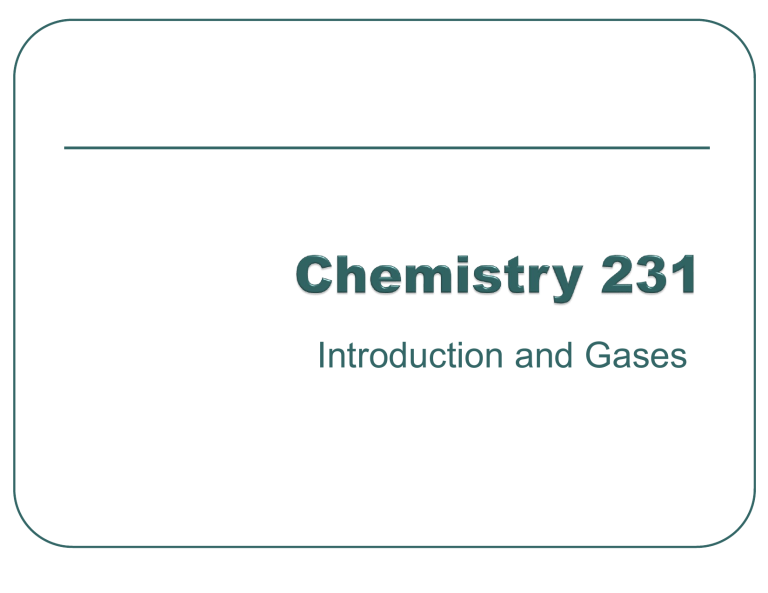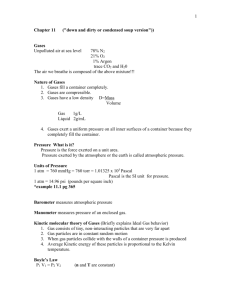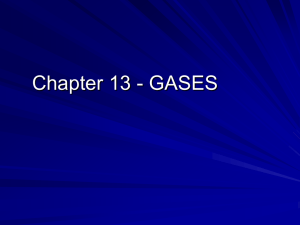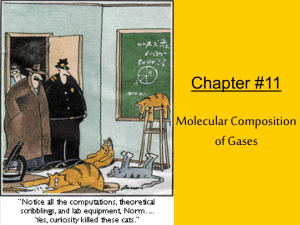Introduction and Ideal Gases

Introduction and Gases
Physics - study of the properties of matter that are shared by all substances
Chemistry - the study of the properties of the substances that make up the universe and the changes that these substances undergo
Physical Chemistry - the best of both worlds!
Thermodynamics – the study of energy and its transformations
Thermochemical changes – energy changes associated with chemical reactions
Interested in the numerical values of the state variables (defined later) that quantify the systems at that point in time.
Systems can be either
• macroscopic
• microscopic
Described by variables such as
• temperature (T)
• pressure (P)
• volume (V)
• energy (U)
• enthalpy (H)
•
Gibbs energy (G)
State Variables
• system quantity whose values are fixed at constant temperature, pressure, composition
State Function
• a system property whose values depends only on the initial and final states of the system.
Path Functions
• system quantity whose value is dependent on the manner in which the transformation is carried out.
Examples of state functions
•
H
•
G
•
V
•
T
Examples of path functions
• work (w)
• heat (q)
Metastable - the progress towards the equilibrium state is slow
Equilibrium state - state of the system is invariant with time
Reversible transformation - the direction of the transformation can be reversed at any time by some infinitesimal change in the surroundings
Irreversible transformation - the system does not attain equilibrium at each step of the process
Gas - a substance that is characterised by widely separated molecules in rapid motion
Mixtures of gases are uniform. Gases will expand to fill containers.
Common gases include - O
2 and N the major components of "air"
2
,
Other common gases - F
2
, Cl
2
, H
2
, He, and N
2
O (laughing gas)
The pressure of a gas is best defined as the forces exerted by gas on the walls of the container
Define P = force/area
The SI unit of pressure is the Pascal
1 Pa = N/m 2 = (kg m/s 2 )/m 2
How do we measure gas pressure?
We use an instrument called the barometer - invented by Torricelli
Gas pressure conversion factors
•
1 atm = 760 mm Hg = 760 torr
•
1 atm = 101.325 kPa = 1.01325 bar
•
1 bar = 1 x 10 5 Pa (exactly)
Experiments with a wide variety of gases revealed that four variables were sufficient to fully describe the state of a gas
•
Pressure (P)
•
Volume (V)
•
Temperature (T)
•
The amount of the gas in moles (n)
The gas volume/pressure relationship
The volume occupied by the gas is inversely proportional to the pressure
V
1/P
• note temperature and the amount of the gas are fixed
V
V
P
1/P
Defines the gas volume/temperature relationship.
V
T (constant pressure and amount of gas)
Note T represents the temperature on the absolute (Kelvin) temperature scale
V
(-273
C = 0 K)
Absolute Zero t /
C
Lord Kelvin – all temperature/volume plots intercepted the t
273.15
°C). c axis at -
Kelvin termed this absolute 0 – the temperature where the volume of an ideal gas is 0 and all thermal motion ceases!
T (K) = [ t c
( °C) + 273.15°C] K/°C
•
Freezing point of water: t c
= 0 °C; T = 273.15
K
•
Boiling point of water: t c
= 100 °C; T = 373.15
K
•
Room temperature: t
•
NOTE t c c
= 25 °C; T = 298 K
=
°C; T (K) = K NO DEGREE SIGN
The pressure/temperature relationship
For a given quantity of gas at a fixed volume, P
T, i.e., if we heat a gas cylinder, P increases!
The volume of a gas at constant T and
P is directly proportional to the number of moles of gas
V
n => n = number of moles of gas
We have four relationships
•
V
1/P; Boyle’s law
•
V
T; Charles’ and Gay-Lussac's law
•
V
n; Avogadro’s law
•
P
T; Amonton’s law
R
Combine these relationships into a single fundamental equation of state the ideal gas equation of state
8 .
314
K
PV
J mole nRT
0 .
08206
L atm
K mole
An ideal gas is a gas that obeys totally the ideal gas law over its entire P-V-T range
Ideal gases – molecules have negligible intermolecular attractive forces and they occupy a negligible volume compared with the container volume
Define: STP (Standard Temperature and Pressure)
•
Temperature - 0.00
°C = 273.15 K
•
Pressure - 1.000 atm
•
The volume occupied by 1.000 mole of an ideal gas at STP is 22.41 L!
Define: SATP (Standard Ambient
Temperature and Pressure)
•
Temperature - 25.00
°C = 273.15 K
•
Pressure - 1.000 bar (10 5 Pa)
•
The volume occupied by 1.000 mole of an ideal gas at SATP is 24.78 L!
Let's consider two ideal gases (gas 1 and gas 2) in a container of volume V.
2
2
1
2
1
1
2
1
2
2
1
1
2
1
The pressure exerted by gas #1
•
P
1
= n
1
RT / V
The pressure exerted by gas #2
•
P
2
= n
2
RT / V
The total pressure of the gases
• p
T
= n
T
RT / V n
T represents the total number of moles of gas present in the mixture
P
1 and P
2 are the partial pressures of gas 1 and gas 2, respectively.
•
P = P
1
+ P
2
= n
T
(R
T
/V)
•
P
T
T
= P
• note P
1 j
+ P
2
+ P
3
=
j
P
J is known as the partial pressure of gas j
Gaseous mixtures - gases exert the same pressure as if they were alone and occupied the same volume.
The partial pressure of each gas, P i related to the total pressure by P
P
T i
, is
= X i
X j
•
X is the mole fraction of gas i.
j
= n j
/ n
T
In the limit of low pressures
T lim p 0
PV nR
The Isothermal Compressibility
T
V
1
V
P
T
The coefficient of thermal expansion
V
1
V
T
P








